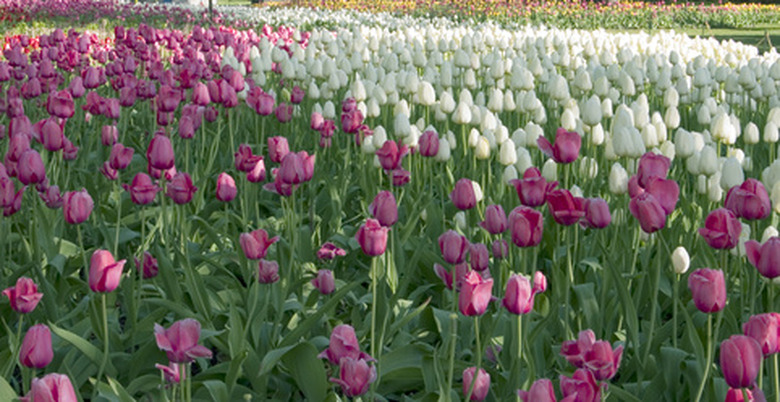Adaptation Of Tulips
Tulips in the wild grow in a variety of habitats in western Asia, from moist valleys to arid mountain slopes. In general, the summers are dry and even the valleys lose much of their moisture. You'll find tulips growing in grassy meadows, separate rather than in large clumps. Their evolution has prepared them to survive well in these open, exposed habitats with cold, moist winters and warm, dry summers.
Adaptation Effects
As species develop, their features change as the individuals that produce more offspring influence the gene pool as a whole. For instance, the waxy, somewhat stiff petals of tulips are good protection from cold, drying winds for the stamens and pistils. It is likely that the tulips with more vulnerable petals lost their flowers to late frosts or a desiccating wind. The waxy-petaled flowers ripened more seed and became the parents of a new generation of tulips with tougher blooms.
- Tulips in the wild grow in a variety of habitats in western Asia, from moist valleys to arid mountain slopes.
- It is likely that the tulips with more vulnerable petals lost their flowers to late frosts or a desiccating wind.
Types of Adaptations
Almost every feature of a wild tulip has some benefit for the plant. Bulbs that can preserve a new sprout inside a store of food release the plant from dependence on summer water. Their ability to sprout from deep underground, covered by as much as a foot of soil, guards them from temperature extremes. The thick leaves keep them from drying prematurely. Stiff stems hold the flowers above the surrounding grass as winds sweep down the slope. Even the bright colors may attract specific pollinator insects.
The Bulb
A tulip bulb resembles an onion, with leaf and flower buds at the base enclosed by layers of fleshy scales and a hard outer tunic that protects them. Roots develop from the basal plate just below the bud. This compact package is well suited for survival in rocky soil or heavy clay. Small buds on the side of the basal plate develop into new bulb, a method of propagation that allows a plant to duplicate itself without depending on the fragile flower. New bulbs are also produced at the ends of short side shoots called stolons.
- Almost every feature of a wild tulip has some benefit for the plant.
- Small buds on the side of the basal plate develop into new bulb, a method of propagation that allows a plant to duplicate itself without depending on the fragile flower.
Leaves
Leaves have evolved into fleshy, waxy structures that resist drying of the tissues as long as possible. Since tulips grow in full sun, they do not need a large leaf surface to gather light so they produce a small number of leaves with a reduced surface area, typically having only two to six leaves, sometimes quite narrow and grass-like, sometimes broad and strap-shaped.
Adaptations To Cultivation
As humans have selected tulips for traits such as larger flowers, a greater variety of colors and longer bloom time, tulips have also become more tolerant of typical garden conditions. Constant summer water, rich soil and warmer winters are factors that influence the survival of bulbs in gardens. Individuals with bulbs that rot in July rains, for instance, do not produce offspring so they are automatically selected out of the gene pool.
